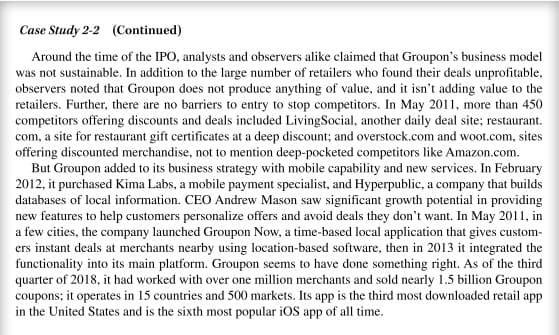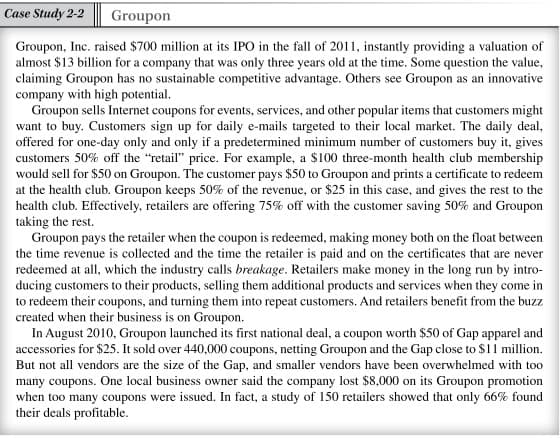How does Groupon add value to the companies whose offers are sold on the site?
Chapter1: Taking Risks And Making Profits Within The Dynamic Business Environment
Section: Chapter Questions
Problem 1CE
Related questions
Question
How does Groupon add value to the companies whose offers are sold on the site?

Transcribed Image Text:Case Study 2-2 (Continued)
Around the time of the IPO, analysts and observers alike claimed that Groupon's business model
was not sustainable. In addition to the large number of retailers who found their deals unprofitable,
observers noted that Groupon does not produce anything of value, and it isn't adding value to the
retailers. Further, there are no barriers to entry to stop competitors. In May 2011, more than 450
competitors offering discounts and deals included LivingSocial, another daily deal site; restaurant.
com, a site for restaurant gift certificates at a deep discount; and overstock.com and woot.com, sites
offering discounted merchandise, not to mention deep-pocketed competitors like Amazon.com.
But Groupon added to its business strategy with mobile capability and new services. In February
2012, it purchased Kima Labs, a mobile payment specialist, and Hyperpublic, a company that builds
databases of local information. CEO Andrew Mason saw significant growth potential in providing
new features to help customers personalize offers and avoid deals they don't want. In May 2011, in
a few cities, the company launched Groupon Now, a time-based local application that gives custom-
ers instant deals at merchants nearby using location-based software, then in 2013 it integrated the
functionality into its main platform. Groupon seems to have done something right. As of the third
quarter of 2018, it had worked with over one million merchants and sold nearly 1.5 billion Groupon
coupons; it operates in 15 countries and 500 markets. Its app is the third most downloaded retail app
in the United States and is the sixth most popular iOS app of all time.

Transcribed Image Text:Case Study 2-2
Groupon
Groupon, Inc. raised $700 million at its IPO in the fall of 2011, instantly providing a valuation of
almost $13 billion for a company that was only three years old at the time. Some question the value,
claiming Groupon has no sustainable competitive advantage. Others see Groupon as an innovative
company with high potential.
Groupon sells Internet coupons for events, services, and other popular items that customers might
want to buy. Customers sign up for daily e-mails targeted to their local market. The daily deal,
offered for one-day only and only if a predetermined minimum number of customers buy it, gives
customers 50% off the "retail" price. For example, a $100 three-month health club membership
would sell for $50 on Groupon. The customer pays $50 to Groupon and prints a certificate to redeem
at the health club. Groupon keeps 50% of the revenue, or $25 in this case, and gives the rest to the
health club. Effectively, retailers are offering 75% off with the customer saving 50% and Groupon
taking the rest.
Groupon pays the retailer when the coupon is redeemed, making money both on the float between
the time revenue is collected and the time the retailer is paid and on the certificates that are never
redeemed at all, which the industry calls breakage. Retailers make money in the long run by intro-
ducing customers to their products, selling them additional products and services when they come in
to redeem their coupons, and turning them into repeat customers. And retailers benefit from the buzz
created when their business is on Groupon.
In August 2010, Groupon launched its first national deal, a coupon worth $50 of Gap apparel and
accessories for $25. It sold over 440,000 coupons, netting Groupon and the Gap close to $11 million.
But not all vendors are the size of the Gap, and smaller vendors have been overwhelmed with too
many coupons. One local business owner said the company lost $8,000 on its Groupon promotion
when too many coupons were issued. In fact, a study of 150 retailers showed that only 66% found
their deals profitable.
Expert Solution
This question has been solved!
Explore an expertly crafted, step-by-step solution for a thorough understanding of key concepts.
This is a popular solution!
Trending now
This is a popular solution!
Step by step
Solved in 3 steps

Recommended textbooks for you

Understanding Business
Management
ISBN:
9781259929434
Author:
William Nickels
Publisher:
McGraw-Hill Education

Management (14th Edition)
Management
ISBN:
9780134527604
Author:
Stephen P. Robbins, Mary A. Coulter
Publisher:
PEARSON

Spreadsheet Modeling & Decision Analysis: A Pract…
Management
ISBN:
9781305947412
Author:
Cliff Ragsdale
Publisher:
Cengage Learning

Understanding Business
Management
ISBN:
9781259929434
Author:
William Nickels
Publisher:
McGraw-Hill Education

Management (14th Edition)
Management
ISBN:
9780134527604
Author:
Stephen P. Robbins, Mary A. Coulter
Publisher:
PEARSON

Spreadsheet Modeling & Decision Analysis: A Pract…
Management
ISBN:
9781305947412
Author:
Cliff Ragsdale
Publisher:
Cengage Learning

Management Information Systems: Managing The Digi…
Management
ISBN:
9780135191798
Author:
Kenneth C. Laudon, Jane P. Laudon
Publisher:
PEARSON

Business Essentials (12th Edition) (What's New in…
Management
ISBN:
9780134728391
Author:
Ronald J. Ebert, Ricky W. Griffin
Publisher:
PEARSON

Fundamentals of Management (10th Edition)
Management
ISBN:
9780134237473
Author:
Stephen P. Robbins, Mary A. Coulter, David A. De Cenzo
Publisher:
PEARSON